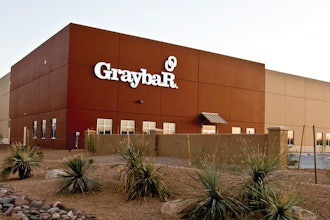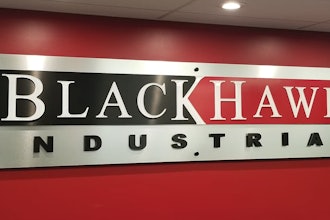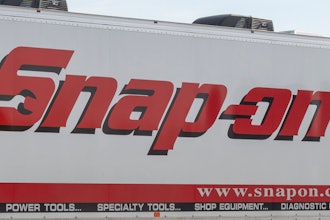Fastenal Company Reports 2013 First Quarter Earnings
Winona, MN - April 10, 2013 (GLOBE NEWSWIRE) -- The Fastenal Company of Winona, MN (Nasdaq:FAST) reported the results of the quarter ended March 31, 2013. Except for per share information, or as otherwise noted below, dollar amounts are stated in thousands.
Net sales (and the related daily sales), pre-tax earnings, net earnings, and net earnings per share were as follows for the period ended March 31:
| Three-month period | |||
| 2013 | 2012 | Change | |
| Net sales | $ 806,326 | 768,875 | 4.9% |
| Business days | 63 | 64 | -1.6% |
| Daily sales | $ 12,799 | 12,014 | 6.5% |
| Pre-tax earnings | $ 175,172 | 161,129 | 8.7% |
| % of sales | 21.7% | 21.0% | |
| Net earnings | $ 109,048 | 100,194 | 8.8% |
| Net earnings per share (basic) | $ 0.37 | 0.34 | 8.8% |
On March 31, 2013, we had 2,660 stores. During the first three months of 2013, we opened 11 new stores, an increase of 0.4% since December 2012 (we increased our store count by 1.9% since March 31, 2012). On March 31, 2013, we operated 25,447 FAST SolutionsSM (industrial vending) machines. During the first three months of 2013, we installed 4,352 new machines, an increase of 20.6% since December 2012 (we increased our machine count by 159.7% since March 31, 2012). On March 31, 2013, we had 15,339 employees, an increase of 1.3% since December 2012.
Similar to previous quarters, we have included comments regarding several aspects of our business:
- Monthly sales changes, sequential trends, and end market performance — a recap of our recent sales trends and some insight into the activities with different end markets.
- Growth drivers of our business — a recap of how we grow our business.
- Profit drivers of our business — a recap of how we increase our profits.
- Statement of earnings information — a recap of the components of our income statement.
- Operational working capital, balance sheet, and cash flow — a recap of the operational working capital utilized in our business, and the related cash flow.
While reading these items, it is helpful to appreciate several aspects of our marketplace: (1) it's big, the North American marketplace for industrial supplies is estimated to be in excess of $160 billion per year (and we have expanded beyond North America), (2) no company has a significant portion of this market, (3) many of the products we sell are individually inexpensive, (4) when our customer needs something quickly or unexpectedly our local store is a quick source, (5) the cost to manage and procure these products can be significant, and (6) the cost to move these products, many of which are bulky, can also be significant.
Our motto is Growth through Customer Service. This is important given the points noted above. We believe in efficient markets — to us, this means we can grow our market share if we provide the greatest value to the customer. We believe our ability to grow is amplified if we can service our customer at the closest economic point of contact.
The concept of growth is simple—find more customers every day and increase your activity with them. However, execution is hard work. First, we recruit service minded individuals to support our customers and their business. Second, we operate in a decentralized fashion to help identify the greatest value for our customers. Third, we build a great machine behind the store to operate efficiently and to help identify new business solutions. Fourth, we do these things every day. Finally, we strive to generate strong profits; these profits produce the cash flow necessary to fund the growth and to support the needs of our customers.
SALES GROWTH:
Net sales and growth rates in net sales were as follows:
| Three-month period | ||
| 2013 | 2012 | |
| Net sales | $ 806,326 | 768,875 |
| Percentage change | 4.9% | 20.0% |
The increase in net sales in the first three months of 2013 and 2012 came primarily from higher unit sales. Our growth in net sales was impacted by inflationary price changes in our non-fastener products and some price deflation in our fastener products, but the net impacts were limited. Our growth in net sales was not meaningfully impacted by the introduction of new products or services, with one exception, our FAST SolutionsSM (industrial vending) initiative did stimulate faster growth (discussed later in this document). The higher unit sales resulted primarily from increases in sales at older store locations (discussed below and again later in this document) and to a lesser degree the opening of new store locations in the last several years. The growth in net sales at the older store locations was due to the growth drivers of our business (discussed later in this document), and, in the case of 2012, the moderating impacts of the recessionary environment. The change in currencies in foreign countries (primarily Canada) relative to the United States dollar lowered our daily sales growth rate by 0.1% in the first three months of 2013 and 2012.
Our sales growth of 4.9% in the first quarter of 2013 was impacted by the loss of one business day versus the prior year (63 days versus 64). Our sales growth adjusted to a daily basis was 6.5% in the first quarter of 2013. We believe our sales growth was held back partially due to the global economic policy uncertainty.
MONTHLY SALES CHANGES, SEQUENTIAL TRENDS, AND END MARKET PERFORMANCE
Note — Daily sales are defined as the sales for the period divided by the number of business days (in the United States) in the period.
This section focuses on three distinct views of our business — monthly sales changes, sequential trends, and end market performance. The first discussion regarding monthly sales changes provides a good mechanical view of our business based on the age of our stores. The second discussion provides a framework for understanding the sequential trends (that is, comparing a period to the immediately preceding period) in our business. Finally, we believe the third discussion regarding end market performance provides insight into activities with our various types of customers.
MONTHLY SALES CHANGES:
All company sales — During the months in 2013, 2012, and 2011, all of our selling locations, when combined, had daily sales growth rates of (compared to the same month in the preceding year):
| Jan. | Feb. | Mar. | Apr. | May | June | July | Aug. | Sept. | Oct. | Nov. | Dec. | |
| 2013 | 6.7% | 8.2% | 5.1% | |||||||||
| 2012 | 21.3% | 20.0% | 19.3% | 17.3% | 13.1% | 14.0% | 12.1% | 12.0% | 12.9% | 6.8% | 8.2% | 9.7% |
| 2011 | 18.8% | 21.5% | 22.8% | 23.2% | 22.6% | 22.5% | 22.4% | 20.0% | 18.8% | 21.4% | 22.2% | 21.2% |
Stores opened greater than two years — Our stores opened greater than two years (store sites opened as follows: 2013 group — opened 2011 and earlier, 2012 group — opened 2010 and earlier, and 2011 group — opened 2009 and earlier) represent a consistent 'same-store' view of our business. During the months in 2013, 2012, and 2011, the stores opened greater than two years had daily sales growth rates of (compared to the same month in the preceding year):
| Jan. | Feb. | Mar. | Apr. | May | June | July | Aug. | Sept. | Oct. | Nov. | Dec. | |
| 2013 | 5.0% | 6.5% | 3.4% | |||||||||
| 2012 | 18.8% | 17.1% | 16.8% | 14.5% | 10.1% | 11.1% | 9.1% | 8.6% | 9.8% | 3.8% | 5.1% | 6.6% |
| 2011 | 16.0% | 18.4% | 19.4% | 19.6% | 19.2% | 19.1% | 18.7% | 16.5% | 15.2% | 18.0% | 18.5% | 17.5% |
Stores opened greater than five years — The impact of the economy, over time, is best reflected in the growth performance of our stores opened greater than five years (store sites opened as follows: 2013 group — opened 2008 and earlier, 2012 group — opened 2007 and earlier, and 2011 group — opened 2006 and earlier). This group is more cyclical due to the increased market share they enjoy in their local markets. During the months in 2013, 2012, and 2011, the stores opened greater than five years had daily sales growth rates of (compared to the same month in the preceding year):
| Jan. | Feb. | Mar. | Apr. | May | June | July | Aug. | Sept. | Oct. | Nov. | Dec. | |
| 2013 | 3.2% | 5.6% | 2.3% | |||||||||
| 2012 | 17.4% | 15.8% | 15.7% | 13.7% | 9.0% | 10.2% | 8.3% | 7.9% | 8.5% | 2.6% | 4.6% | 5.6% |
| 2011 | 15.3% | 17.9% | 19.2% | 19.1% | 17.9% | 18.2% | 17.3% | 15.2% | 14.5% | 17.0% | 17.4% | 16.9% |
There are three distinct influences to our growth: (1) execution, (2) currency fluctuations, and (3) economic fluctuations. This discussion centers on (2) and (3). First off, currency — the change in currencies in foreign countries (primarily Canada) relative to the United States dollar impacted our growth over the last several years. During 2011 it lifted our growth by 0.7%, in 2012 it lowered our growth by 0.1% (by quarter the impact was down 0.1%, 0.4%, and 0.2% in the first, second, and third quarters, respectively, and then up in the fourth quarter by 0.2%) and in the first quarter of 2013 it lowered our growth by 0.1%.
Regarding economic fluctuations, in 2011 we enjoyed strong growth. This reflected the strengthening economic environment being experienced by our customers. While the strength did not apply to all customers and to all geographies we serve, it was strong enough to produce acceptable results. During 2012, the growth in the first three and a half months generally continued the relative strength we saw in 2011. Then we experienced two distinct economic slowdowns. The first occurred in the late April/May time frame, and then moderated until September. The second occurred in the October/November time frame. This was exaggerated by an unusual business day comparison in October (23 days in 2012 versus 21 days in 2011 - the maintenance portion of our business is often linked to monthly spend patterns, which are not as business day dependent, this can dilute the daily growth picture given the change in business day divisor) and the impact of Hurricane Sandy. During the first three months of 2013, the weakness has continued. Both January and February experienced some negative impact from weather, and January experienced a very weak start due to extended holiday shutdown. However, with the benefit of hindsight, we believe the economic activity of our customers slowed from January to February and slowed further from February to March. This is evident in the two and five year comparisons above.
SEQUENTIAL TRENDS:
We find it helpful to think about the monthly sequential changes in our business using the analogy of climbing a stairway — This stairway has several predictable landings where there is a pause in the sequential gain (i.e. April, July, and October to December), but generally speaking, climbs from January to October. The October landing then establishes the benchmark for the start of the next year.
History has identified these landings in our business cycle. They generally relate to months with impaired business days (certain holidays). The first landing centers on Easter, which alternates between March and April (Easter occurred in March in 2013, and in April in 2012 and 2011), the second landing centers on July 4th, and the third landing centers on the approach of winter with its seasonal impact on primarily our construction business and with the Christmas / New Year holidays. The holidays we noted impact the trends because they either move from month-to-month or because they move around during the week.
The table below shows the pattern to our sequential change in our daily sales. The line labeled 'Past' is an historical average of our sequential daily sales change for the period 1998 to 2003. We chose this time frame because it had similar characteristics, a weaker industrial economy in North America, and could serve as a benchmark for a possible trend line. The '2013', '2012', and '2011' lines represent our actual sequential daily sales changes. The '13Delta', '12Delta', and '11Delta' lines indicate the difference between the 'Past' and the actual results in the respective year.
Jan.(1) | Feb. | Mar. | Apr. | May | June | July | Aug. | Sept. | Oct. | Cumulative change from Jan. to Mar. | |
| Past | 0.9% | 3.3% | 2.9% | -0.3% | 3.4% | 2.8% | -2.3% | 2.6% | 2.6% | -0.7% | 6.2% |
| 2013 | -0.4% | 2.0% | 3.4% | 5.4% | |||||||
| 13Delta | -1.3% | -1.3% | 0.5% | -0.8% | |||||||
| 2012 | -0.3% | 0.5% | 6.4% | -0.8% | 0.5% | 2.5% | -2.7% | 1.3% | 4.3% | -4.8% | 7.0% |
| 12Delta | -1.2% | -2.8% | 3.5% | -0.5% | -2.9% | -0.3% | -0.4% | -1.3% | 1.7% | -4.1% | 0.8% |
| 2011 | -0.2% | 1.6% | 7.0% | 0.9% | 4.3% | 1.7% | -1.0% | 1.4% | 3.4% | 0.7% | 8.7% |
| 11Delta | -1.1% | -1.7% | 4.1% | 1.2% | 0.9% | -1.1% | 1.3% | -1.2% | 0.8% | 1.4% | 2.5% |
(1) The January figures represent the percentage change from the previous October, whereas the remaining figures represent the percentage change from the previous month.
This report has been truncated. To read the entire report, please visit http://investor.fastenal.com/releasedetail.cfm?ReleaseID=755461.
---
Fastenal Company Announces Cash Dividend
Winona, MN - April 10, 2013 (GLOBE NEWSWIRE) -- The Fastenal Company of Winona, MN (Nasdaq:FAST) reported its Board of Directors declared a dividend of $0.20 per share to be paid in cash on May 30, 2013 to shareholders of record at the close of business on May 2, 2013.
Fastenal began paying an annual dividend in 1991, expanded to a semi-annual dividend in 2003, and then switched to a quarterly dividend in 2011. In 2012, we paid four quarterly dividends of $0.17 in February, $0.17 in May, $0.19 in August, $0.21 in November, and then paid a special supplemental dividend of $0.50 in December. Our dividend payment in the first quarter of 2013 (paid in February) was $0.10 per share. We lowered this dividend payment to partially replenish our cash reserves after the large supplemental dividend payment late in 2012 and to also prepare for the significant capital expenditures we expect in 2013 related to the expanded vending rollout and to distribution automation. We still anticipate the need to draw upon our line of credit during 2013; however, we now believe our cash reserve is at a level to support a second quarter dividend payment more in line with the quarterly dividend amounts paid in 2012.
Our Board of Directors intends to continue paying quarterly dividends, provided that any future determination as to payment of dividends will depend upon the financial condition and results of operations of the Company and such other factors as are deemed relevant by the Board of Directors, such as dividend tax rates.
Dividend and stock repurchase activity in the last ten years are as follows:
|
|
|
|
| Total |
|
|
|
|
|
| value of | Per share |
|
| Total | Dividends per share | repurchased | price of | |
| Dividend | dividends | Regular | Total | shares | repurchased |
Year | payments | paid (000's) | dividend | dividend | (000's) | shares |
|
|
|
|
|
|
|
2013 | Two1 | $ 89,000 | $ 0.30 | $ 0.30 | $ — | $ — |
2012 | Five2 | $ 367,306 | $ 0.74 | $ 1.24 | $ — | $ — |
2011 | Four | $ 191,741 | $ 0.65 | $ 0.65 | $ — | $ — |
2010 | Three2 | $ 182,814 | $ 0.41 | $ 0.62 | $ — | $ — |
2009 | Two | $ 106,943 | $ 0.36 | $ 0.36 | $ 41,104 | $ 18.69 |
2008 | Three2 | $ 117,474 | $ 0.26 | $ 0.395 | $ 25,958 | $ 22.00 |
2007 | Two | $ 66,216 | $ 0.22 | $ 0.22 | $ 87,312 | $ 20.93 |
2006 | Two | $ 60,548 | $ 0.20 | $ 0.20 | $ 17,294 | $ 18.25 |
2005 | Two | $ 46,935 | $ 0.155 | $ 0.155 | $ 18,739 | $ 13.38 |
2004 | Two | $ 30,350 | $ 0.10 | $ 0.10 | $ — | $ — |
1 The total dividends paid amount includes the estimated impact from this announcement. The estimate is calculated using the 296.7 million shares outstanding at the end of the previous quarter.
2 There was a supplemental dividend paid in December 2012, 2010, and 2008.
All per share information reflects the two-for-one stock splits in both 2011 and 2005.
Fastenal sells different types of industrial and construction supplies in the following product categories: threaded fasteners and miscellaneous supplies; tools; metal cutting tool blades and abrasives; fluid transfer components and accessories for hydraulic and pneumatic power; material handling; storage and packaging products; janitorial, chemical and paint products; electrical supplies; welding supplies; safety supplies; metals, alloys and materials; and office supplies.
Additional information regarding Fastenal is available on the Fastenal Company World Wide Web site at www.fastenal.com.
The Fastenal Company logo is available at http://www.globenewswire.com/newsroom/prs/?pkgid=6432.
This press release contains statements that are not historical in nature and that are intended to be, and are hereby identified as, "forward-looking statements" as defined in the Private Securities Litigation Reform Act of 1995, including a statement regarding expectations as to payment of a quarterly cash dividend in the foreseeable future. Any future determination as to payment of dividends will depend upon the financial condition and results of operations of the Company and such other factors as are deemed relevant by the Board of Directors. For example, a change in business needs including working capital and funding for acquisitions, or a change in tax law relating to dividends, could cause the Company to decide not to pay a dividend in the future. A discussion of other risks and uncertainties is included in the Company's 2012 annual report on Form 10-K under the section captioned "Risk Factors" and the Company's 2012 annual and 2013 quarterly reports under the section captioned "Management's Discussion and Analysis of Financial Condition and Results of Operations." FAST-D






















